Immigrants Going Through Ellis Island in 1913
By DR. ALFRED C. REED, U. S. Public Health Service, Ellis Island
IT is at least a question whether the visitor to Ellis Island looks at the newly landed immigrant with eyes any more curious than those with which the immigrant looks at the visitor.
The one sees the timidity, the surprise, the fear and the expectation of the new-corner. The other sees what is to him a wonderful model of all that is American.
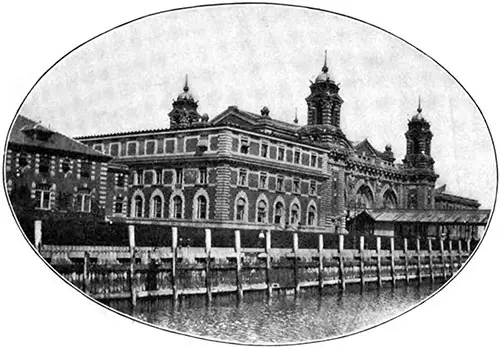
Main Immigration Building at Ellis Island. The Popular Science Monthly, January 1913. GGA Image ID # 14e21f8d43
It is a busy island. Yet in all the rushing hurry and seeming confusion of a full day, in all the babel of language, the excitement and fright and wonder of the thousands of newly-landed, and in all the manifold and endless details that make up the immigration plant, there is system, silent, watchful, swift, efficient.
Five thousand immigrants in a day is no uncommon figure. Five thousand six hundred passed through last Easter Sunday. Five hundred and twenty-five persons are employed on the island exclusive of the score of medical officers and the hundred or more attendants of the Public Health Service.
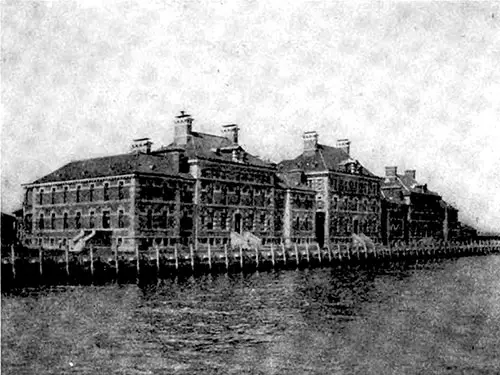
The Immigrant Hospital at Ellis Island. The Popular Science Monthly, January 1913. GGA Image ID # 14e2254cde
It is an island crowded full of pathos and tragedy, of startling contrasts and unexpected humor. A burly, laughing giant of a man came down the line one afternoon, elated to have reached the land of his lifelong hope. The next morning he lay stricken with meningitis and that evening was dead.
A young mother was separated from her two-year-old baby because the baby had diphtheria. In a few days the baby died, and the mother went on alone to the father waiting in the west.
The reunion of broken families, and the old folks coming to live in the home prepared by the pioneer children, constantly afford views of human nature unmasked and unrestrained.
All races and conditions of men come together here and adjust themselves more or less amicably to each other. Children with no common bond of race, language or religion, play together perhaps more happily for that very reason.
Some have been here for months. In the New York room, a Flemish couple have waited seven long months for a little girl who is still sick in the hospital.
Every morning on his rounds they ask the doctor how soon she can come to them, and thrice a week they visit her bedside. Perhaps by now their long waiting. is finished, and she has gone on with them happily to the new home in America.
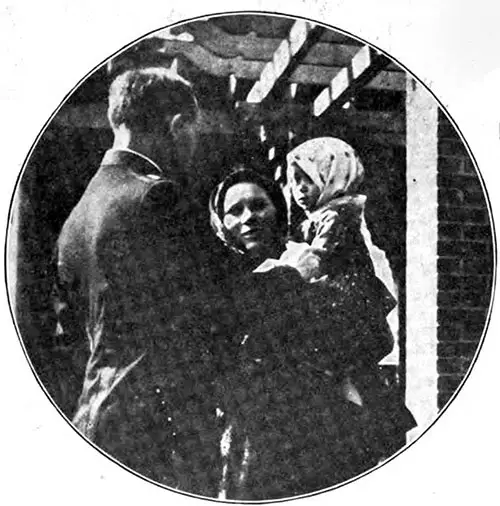
A Polish Mother Holding Her Baby Up To See The Doctor. The Popular Science Monthly, January 1913. GGA Image ID # 14e26b4ce4
America is the land of the alien, and even now his mark is plain on all our institutions. But while the principal increase in population has been by immigration, the character of that immigration has changed markedly in the past thirty years.
Previous to 1883, western and northern Europe sent a stalwart stock, 95 per cent. of all who came. They sought new homes and were settlers.
Scandinavians, Danes, Dutch, Germans, French, Swiss and the English islanders, they were the best of Europe's blood. They were industrious, patriotic and farsighted.
They were productive and constructive workers. Where nothing had been, they planted, and mined, and built, and toiled with their hands, while yet finding time to educate their children and train them to love the new mother-country and appreciate the blessings she furnished.
But for three decades the immigrant tide has flowed more and more from eastern and southern Europe. The others still come, but they are far outnumbered by the Jews, Slays, the Balkan and Austrian races, and those from the Mediterranean countries.
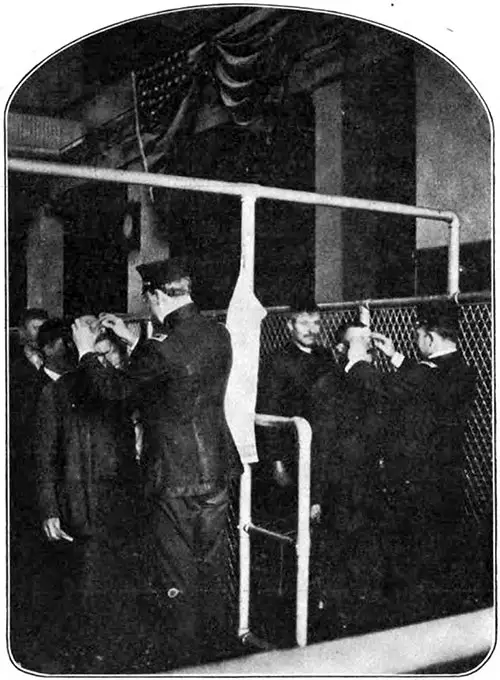
Examining Eyes on the Line at Ellis Island. The Popular Science Monthly, January 1913. GGA Image ID # 14e304831a
In contrast with the earlier immigration, these peoples are less inclined to transplant their homes and affections. They come to make what they can in a few years of arduous unremitting labor, and then return to their homes to spend it in comparative comfort and ease.
It has been well said that America is their workshop, Europe their home. Thirty per cent. of them return to their former homes.
As a class, they contribute little of lasting value but the work of their hands for which they are well paid. And from what they earn they send home no small pact. In 1907 they sent $275,000,000 out of the country.
True, this money was earned, but its greater value in investment and development was lost. In contrast to their predecessors, the immigrants since 1883 tend to form a floating population.
They do not amalgamate. They are here in no small degree for what they can get. It is not always true that they come to supply a real demand.
The periodical advertisement of a national demand for cheap labor does not spring from a true economic need, even though the influx of cheap labor might put more money in the employer's pocket.
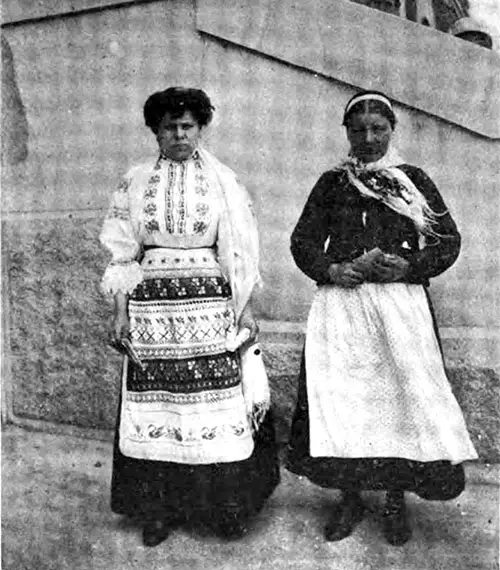
Russian Immigrant Girls at Ellis Island. The Popular Science Monthly, January 1913. GGA Image ID # 14e353c321
Such is the type of the newer immigration, and its changing and deteriorating character makes restriction justifiable and necessary. No one can stand at Ellis Island and see the physical and mental wrecks who are stopped there, or realize that if the bars were lowered ever so little the infirm and mentally unsound would come literally in hordes, without becoming a firm believer in restriction and admission of only the best.
The average citizen does not realize the enormous numbers of mentally disordered and morally delinquent persons in the United States nor to how great an extent these classes are recruited from aliens, and their children. Restriction is vitally necessary if our truly American ideals and institutions are to persist, and if our inherited stock of good American manhood is not to be depreciated.
This restriction can be made operative at various points, but the key to the whole situation is the medical requirement. No alien is desirable as an immigrant if he be mentally or physically unsound, while, on the other hand, mental and physical health in the wide sense carries with it moral, social and economic fitness.
The present United States immigration law (legislation of 1907) is very definite in its statement of medical requirements for admission.
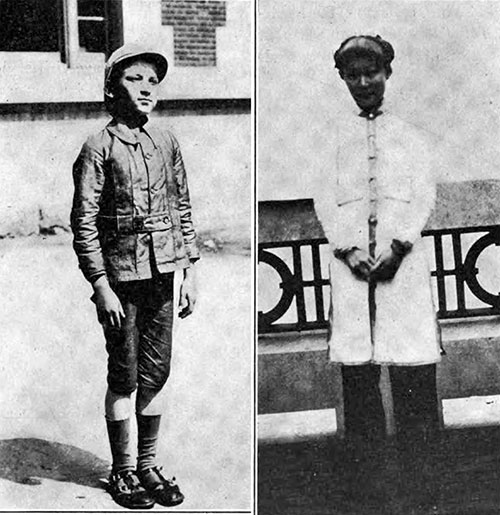
A Russian Jewish Boy, Just Landed (l) and A Chinese Girl in the Detention Quarters. The Popular Science Monthly, January 1913. GGA Image ID # 14e359d030
The law divides physically and mentally defective aliens into three classes. Class A includes those whose exclusion is mandatory under the law because of a specified defect or disease. In this class are idiots, imbeciles, epileptics, the feebleminded, insane and those subject to tuberculosis, or a dangerous or loathsome contagious disease.
When a medical diagnosis has been made of these conditions, that person is automatically excluded. In Class B are conditions which are not mentioned in Class A, but which make the person affected liable to become a public charge or affect his ability to earn a living.
Class C includes defective and diseased conditions not included under A or B but which must nevertheless be certified for the information of the immigration officials.
The medical inspection of all immigrant aliens is performed by officers of the United States Public Health Service. This service dates from an act of congress in 1798 creating the original Marine Hospital Service, which conducted hospitals at all large ports and inland waterway cities for seamen of the American merchant marine.
The duties of the service have since been enlarged to include all features of national health protection. Its officers rank equal with those of the army and navy medical corps, and are found in all parts of the world pursuing their investigations and carrying out measures to protect the public health of the United States.
The medical inspection of immigrants is not the least important of their functions. The Bureau of Immigration is under the Department of Commerce and Labor, while the Public Health Service is under the direction of the Secretary of the Treasury.
There are 82 immigration stations embracing the entire coastline and frontiers of the United States as well as the entry of aliens into the Philippines, Porto Rico and Hawaii.
During the fiscal year of 1911, the total number of immigrants examined was 1,093,809. Of these 27,412 were certified for some mental or physical defect. By far the most important point of entry is Ellis Island, where 749,642 aliens were examined. Nearly 17,000 medical certificates were issued here, and more than 5,000 of these were deported.
The Ellis Island station of the Public Health Service has 25 medical officers attached, including 6 specially trained in the diagnosis and observation of mental disorders. Their work is divided into three sections, the boarding division, the hospital and the line.
The boarding division has its offices at Battery Park, N. Y. By means of a fast and powerful cutter, The Immigrant, these men meet all incoming liners as they leave the New York Quarantine Station and start up the bay.
Their inspection is limited to aliens in the first and second cabins. Such as require a more careful and detailed examination are sent to Ellis Island. The others are discharged at the dock, after having passed the additional inspection of the Department of Commerce and Labor.
At the dock, all third and fourth class aliens are transferred to barges, carrying about 700 each, and taken to Ellis Island.
Ellis Island lies close to the Statue of Liberty on Bedloe's Island, about a mile from Battery Park. It is the most commanding location in New York Harbor.
It consists of one small natural island and two additional artificial ones, connected with the first by a covered passageway across the intervening strip of water. On the first island is the main immigration station. The other two are occupied by the hospital division of the medical service.
On one of these is the general hospital and on the further one the contagious hospital, consisting of separate pavilions, connected with open covered passageways.
Each hospital can accommodate close to 200 patients at once, and is usually fairly full. The service is limited strictly to aliens, and the expense of each immigrant receiving hospital care is charged to the steamship company which brought him.
This hospital is excellently conducted and every method of most approved diagnostic, surgical and medical technique is practiced. A rare variety of diseases is seen. Patients literally from the farthest corners of the earth come together here.
Rare tropical diseases, unusual internal disorders, strange skin lesions, as well as the more frequent cases of a busy general city hospital present themselves.
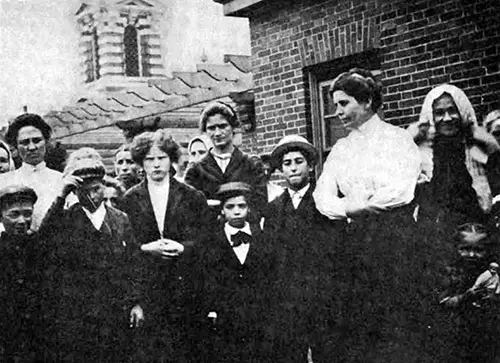
The Matron and Some of Her Charges on the Roof at Ellis Island. The Popular Science Monthly, January 1913. GGA Image ID # 14e35d5c1e
The variety of contagious diseases is unusual and extreme diagnostic skill is required of the physicians in charge. In the fiscal year 1911, over 6,000 cases were treated in the hospital, exclusive of 720 cases transferred to the Quarantine Hospital at the Harbor entrance before the completion of the present contagious hospital on Ellis Island.
The third division of the medical inspection is "the line" or primary inspection. This is the part that the visitor to the island sees, and has been often described.
Suffice it to say that as the immigrants leave the barges they pass in single file before the medical officers who pick out all who present evidence of any mental or physical defect. They are turned aside into the medical examining rooms for more careful observation.
Each defect or disease receives a medical certificate signed by three physicians, which places the bearer in one of the three classes already mentioned.
Those who require immediate medical or surgical care for any reason are transferred to the hospital, as are also certain cases in which longer observation and more detailed examination are necessary for diagnosis. Examples of this are tuberculosis, parasitic scalp diseases, mental disorders and trachoma.
Having been certified or passed clear in the medical division, the immigrant goes together with those from the barge who have not been turned aside, to the upper or registry floor, for the inspection of the immigration authorities.
These inspectors ask the same questions that the immigrant was required to answer when the ship's manifest was filled out before embarkation.
This covers such information as name, age, destination, race, nativity, last residence, occupation, condition of health, nearest relative or friend in the old country, who paid his passage, whether in United States before, whether ever in prison, whether a polygamist or anarchist, whether coming under any contract labor scheme, and personal marks of identification such as height, and color of eyes and hair. Any discrepancies in the answers are noted.
The immigrant is also required to show what money he has. All who do not meet these questions satisfactorily or who hold medical certificates of classes A or B, are held for a rigid examination before a Board of Special Inquiry, which decides whether or not they shall be admitted.
Each of these boards consists of three members, the decision of two members being final. The hearings of the hoards are private, but a complete copy of the proceedings is 'made and filed in Washington.
Those who are to he deported are held on the island until the vessel on which they came is ready for its return voyage. In the event of deportation being ordered, the alien may appeal from the decision of the board to the commissioner of the port, from him to the commissioner-general of immigration, and then to the Secretary of Commerce and Labor.
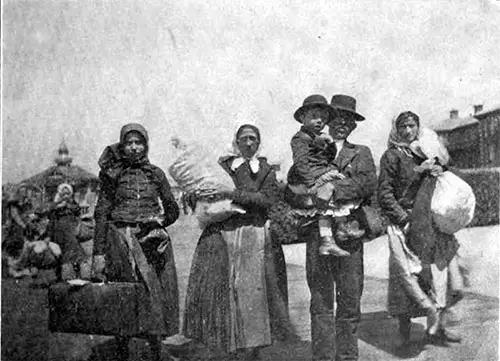
Immigrant Family's First Photograph Taken at Ellis Island. The Popular Science Monthly, January 1913. GGA Image ID # 14e379d75b
Those immigrants who have passed satisfactorily and are bound for New York City are sent to the " New York room " to await friends or responsible parties who come for them.
This is one of the most dramatic and thrilling spots on the island, for it is the reunion place of friends, relatives and lovers. The Irish girl who came two years ago meets the sister and the old mother.
The one is pale, nervous, and clad in New York garb: the others have never seen the ocean until their good ship sailed, and their brilliant cheeks and country dress are in keeping with their dense ignorance and shyness.
They know the price of shoes and what spuds are worth at market, but it is beyond them to recall the date of their birthday, or what the present month may be.
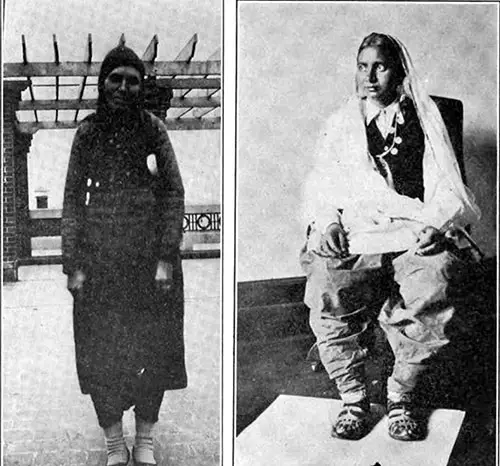
A Serbian Woman (left) and a woman from Hindustan Wearing a Genuine Harem Skirt. Photographs taken at Ellis Island. The Popular Science Monthly, January 1913. GGA Image ID # 14e3a8181e
Those immigrants who are destined for points other than New York City are sent to the railroad room. Here they change their money for United States coin, and buy their railroad tickets under careful supervision.
Their baggage is checked, they have a telegraph, cable and post office of their own, and may buy lunches whose contents are exhibited to all in glass cases.
Special agents see that each one buys a lunch proportioned to the size of his family and the length of his journey. Cigars, cakes and fruits are also to be had.
One day a stolid and emotionless Slavish woman opened her cardboard lunch box at the bottom and extracted a piece of bologna cut on the bias, smelled it carefully from different sides, licked it, finally tasted it, and then broke into a flood of smiles as she pressed it forcibly into the mouth of her equally stolid two-year-old baby. And the baby sucked and munched on the new world dainty in undiscerning pleasure!
But the greatest mystery in the lunch box is usually the small round fruit pie. Some carefully raise the crust and extract the contents with a much-used finger.
Another whittles it off in slices with a murderous knife a foot in length, while another will carefully eat off all the crust and discard the interior. A bearded Cossack with great care and patience chewed a hole through one corner of a tin of sardines.
Then with praiseworthy perseverance, he sucked out the oil! From the railroad room, the immigrants are taken in barges to the depot of the railroad on which their journey is to be made.
Those immigrants who are to be deported, or who for any reason must be kept on the island some time, are placed in the detention quarters. These are not open to visitors.
Tiers of beds are provided, accommodating 1,800 persons, but often this number is exceeded by 500. These quarters are among the most interesting points on the island.
The women and children of all races and tongues are in one large room, and the men in another. In mild weather they are all sent on to the fine broad roof of the building.
Not long ago a Danish woman who could speak no English and whose baby was in the hospital with diphtheria, became a second mother to a coal-black pick a ninny, who had come up from Trinidad on a coffee-ship and whose mother was also in the hospital.
Again race wars occur among the children, and Turks and Armenians will battle ferociously with Italians. Mention should be made of the large immigrant dining-room which seats 1,100, where the missionary societies hold a polyglot Christmas entertainment each year.
But the observer at Ellis Island sees only the immigrant stream flowing in. He does not see what results when it has been distributed over the country. No graver questions are before the American nation today than those associated with immigration, and none whose correct solution demands more imperative attention.
One of these vital questions which is in special prominence just now, is the relation of immigration to mental disorders. This question concerns New York state more acutely than other states only because New York has the largest number of alien defectives.
In February, 1912, there were 33,311 committed insane cases in New York state institutions.
It is estimated that more than 8,000 of these or, roughly, 25 per cent., are aliens, and this is exclusive of those conditions of mental defectiveness listed under idiocy, imbecility and feeblemindedness.
In the New York schools there are about 7,000 distinctly feeble-minded children, or about 1 per cent. of the school population. Again this does not include idiots and imbeciles to an equal number, not attending school, nor border-line cases and morally defective children.
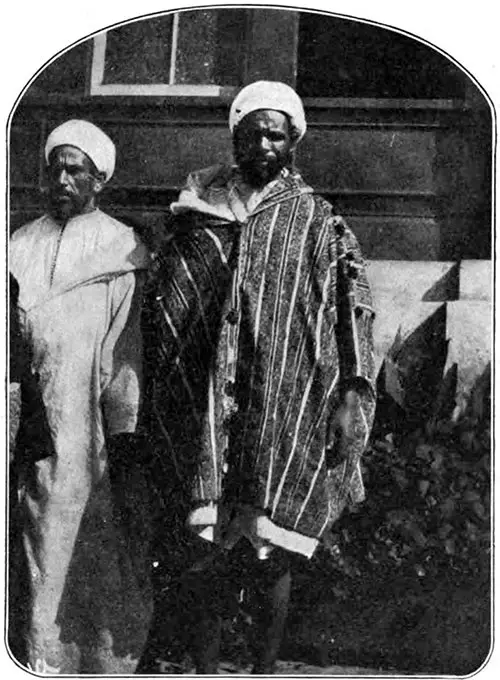
Two African Arabs, Awaiting the Medical Examination. The Popular Science Monthly, January 1913. GGA Image ID # 14e3f05e0a
The total number of feeble-minded children in New York is about 10,000. According to the figures of the last census, 30 per cent. of the feeble-minded children in the general population throughout the country are the progeny of aliens or naturalized citizens. Thus the presence of 3,000 of New York's feeble-minded children can safely be laid to immigration.
These figures show the extreme necessity of careful medical inspection of immigrants. But there are many complicating factors. It is very difficult to recognize many types of insanity. It is almost impossible to detect feeblemindedness in infants and young children.
Yet in spite of this, the medical officers at Ellis Island are doing thorough and effective work, and do not at all deserve the ignorant criticism of those unfamiliar with the difficulties .of that work.
A point where criticism is unfortunately valid is in the matter of the deportation of aliens who within three years after landing show themselves subject to any of those conditions which the law excludes, or who become public charges from any cause, said condition or cause having existed prior to landing.
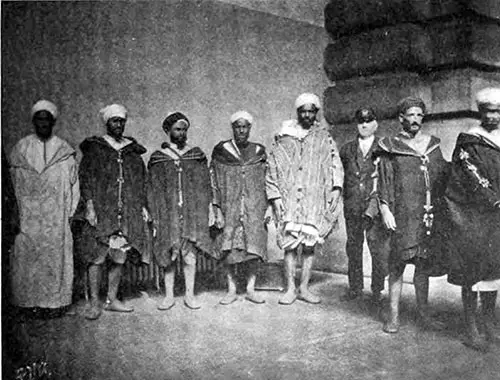
Berbers from Algeria - Filling an Engagement at a New York Theater. The Popular Science Monthly, January 1913. GGA Image ID # 14e4007c00
If the present entrance inspection was reinforced by a determined administration of these deportation laws, and if all cases whose exclusion the law makes mandatory, and which are now certified by the medical officers, were actually excluded, there would be little cause for complaint. But such a condition does not obtain.
The medical officers have nothing whatever to do in passing judgment on whether an immigrant shall be admitted or not. Their province alone is to certify to his physical and mental status. The question of admission, as well as of deportation, rests with the officials of the Department of Commerce and Labor.
Much easier is the control of organic physical diseases, as, for example, hookworm infection. A survey of the prevalence of hookworm disease throughout the world, made by the Rockefeller Sanitary Commission, shows that this infection belts the world in a zone 66° wide with the equator near its middle, and that practically every country in this zone is heavily infected. It is evident how grave a danger lurks in immigration from any country where the hookworm is prevalent.
Among the worst afflicted countries is India, where it is estimated that from 60 to 80 per cent. of the population of 300,000,000 harbor this parasite.
This leads peculiar interest to the movement of Hindu coolies into the United States in the last few years. A shipload of these coolies landing recently in San Francisco were found by the health authorities of that port to have 90 per cent. infected with hookworm.
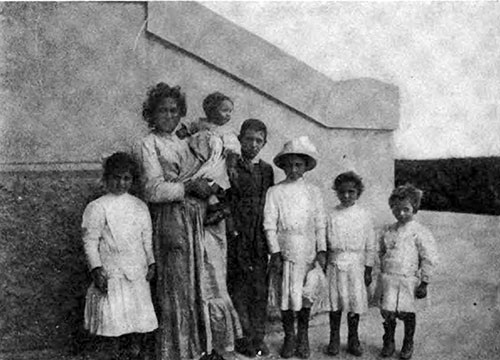
An Italian Immigrant Family -- a Mother and Five Children. The Popular Science Monthly, January 1913. GGA Image ID # 14e4577514
Every colony and camp of Hindus in California today is a dangerous source of infection to all the country around. A rigid quarantine has been established against further importation of this class of aliens.
There are numerous other questions besides those which have been touched on here. Immigration presents one of the most serious problems facing this country. Ellis Island is where the needs and dangers of the country in this regard are focused.
Its ever-changing stream of humanity furnishes a fascinating realm for the student of human nature, as well as for study of the great question of economics and eugenics which are involved.
Dr. Alfred C. Reed, "Going Through Ellis Island," in The Popular Science Monthly, New York: The Science Press, Vol. LXXXII, No, 1, January 1913, pp. 5-18.
